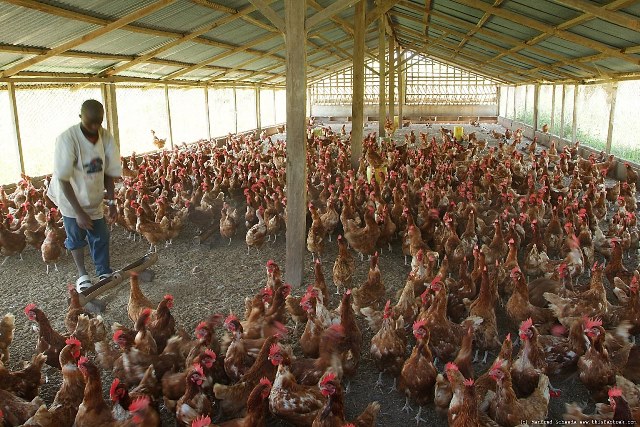
One unavoidable point worth dissecting is the fact that the millennial Ghanaian consumer appears to have a preference for more mature chicken with harder bones, thicker meat and a certain indigenous taste — the types that are usually raised at home, as casual domestic hobbies, with no commercial intent.
It is all good, but truth be told, those are not raised in organised, commercial quantities and are not under strict regulatory supervision.
Since that certainly does make them more expensive to produce and sell. Hence, the tendency to wait for the ‘spent layers’ which, after 75 weeks of playing their ‘born-to-breed’ roles, get released onto the market.
Here’s the catch though: purchasing mature birds at heavier weights and yet at affordable prices is totally attainable if the market base is wide and guaranteed since that would motivate local producers to opt for leaner profit margins spread over large stocks. The other option would be to wait for ‘spent layers’.
FSRP-MOFA poultry intensification scheme
In a determined move to claw into this entire phenomenon, save the nation about $300m, as well as create valuable and sustainable value chain jobs, the Ministry of Food and Agriculture (MoFA) has targeted broiler poultry production of 420,000 tonnes (which constitutes 111 per cent national self-sufficiency) by 2028.
Under this annually staggered arrangement, Ghana was expected to attain 12.7 per cent (42,610 MT) by the end of 2024, through the facilitation of the supply of improved breed of broilers; facilitation of the expansion of processing facilities (through Matching Grants); provision of adequate animal husbandry/ health services and training; and facilitation of access to structured market arrangements.
In line with this, the West Africa Food System Resilience Programme (FSRP) under MoFA, through World Bank funding, has rolled out the Poultry Intensification Scheme (PIS), which is being run in phases.
The PIS beneficiaries are receiving input credit in the form of day-old chicks, feed supplies, as well as supplies of vaccines.
They are also being trained in the best modern practices and climate-smart technologies within the poultry industry.
They will further be able to access matching grants to procure equipment to support post-production processing and cold storage.
The scheme targets the production of approximately two million broiler birds yearly, under a $12.5m World Bank facility.
Under the scheme, commercial anchor farmers and their out-growers nationwide are getting this support to produce, process and market two million birds annually over the next three years.
FSRP strides so far
To that end, since July 2024, FSRP has facilitated input credit to 22 anchor farmers in six regions (Ashanti, Bono, Oti, Greater Accra, Central and Eastern) by way of 360,500 day-old chicks, 911, 000 doses of vaccines (HBI, Lasota, Umboro 1 & 2) and 4.5kg of feed per bird – totalling 1,179,000 kg of feed; in all, amounting to approximately GH¢13.5m so far.
As a result, within four months (as of November 2024), the Poultry Intensification Scheme has led to the production of 400,000 birds. The anchor farmers have further drafted beneficiary out-grower farmers into the game.
FSRP broilers are raised under the prying eyes of an entire community of state regulatory bodies and experts.
Monitoring teams made up of officials of the Animal Production Directorate (APD-MOFA), the Veterinary Services Dept (VSD-MOFA), as well as FSRP’s team of technical specialists, together with regulatory officials inspect the poultry farms and processing facilities to ascertain their adherence to laid down industrial standards such as feed quality, vaccination timeliness, bio-security protocols, stipulated weights, microbiology checks and the general health care of the birds.
Unfortunately, these cannot be guaranteed when it comes to imported poultry. Some are alleged to be produced without regulatory oversight.
This means necessities such as timely vaccinations, approved feed types, proven hygienic raising methods, storage of the processed birds within strictly stipulated temperatures, etc, cannot be verified or guaranteed.
They may come in with all the required import documentation, but that may just be paperwork, which may well be filled with nothing but a ‘copy and paste’ cocktail of concocted stories.
These questions will, therefore, forever flutter: What quality control measures are observed in the production chains of imported poultry?
Under what conditions are they raised, cared for, slaughtered and dressed?
How certain are we that they were disease-free before slaughter?
Under what conditions are they frozen after processing?
How long are they kept before getting transported overseas and how long do they float on the seas before they arrive in our markets? How long were they kept in those cold stores there and here? Under what regulatory temperatures?
After slaughtering, processing, chilling, blast freezing, cold transportation, delivery at the retail shop, etc (all under regulatory requirements), GH chicken can hit dining tables within 24 hours! Can we guarantee the same for imported chicken?
Flocking together
Some have fumed, understandably, “Why doesn’t the government just place a gripping ban on imported chicken?
That should give the local industry some leverage and space to grow!”
But as the FSRP Project Coordinator warns: first, that move would be gravely counter-productive, since we don’t have the capacity yet to meet the hefty local demand.
It would trigger blistering inflation on chicken, among other rippling effects.
Secondly, FSRP is all about promoting open trade in food and agricultural produce within the West African sub-region.
Indeed, consumers from neighbouring countries cross over to purchase some chicken from Ghana.
The FSRP approach, therefore, is to work to gradually reduce imports, by using home advantage to take over the local poultry market and even export.
Moreover, players in the poultry importation business are invited to take advantage of the Poultry Intensification Scheme and switch over to local production and exportation.
That should be a hassle-free easier sell, besides serving the greater national good.
The ‘Cluck’ is ticking!
Remember, a bite into imported chicken is a bite out of the Ghanaian economy, with a clear and present effect on jobs, exchange rates, nationwide public services, and believe it or not, salaries – not to mention the highly possible loss of nutritional value and imminent health risks to our populace (especially children and students), may be exposed to.
As the MoFA emphasised at the FSRP stand during the 2024 National Farmers Day Exhibition, the slightly higher cost of homegrown poultry is not as cut-throat as alleged, given the health and nutritious sway they have over imported ones.
Sustained patronage
Moreover, with FSRP support and sustained consumer patronage, the prices will level up in no time.
This calls for all players in the industry (including anchor farmers, outgrowers, input suppliers, marketers, etc) to pitch in to hold down $300m for themselves and prevent all that cash from flying off our shores.
Consumer groups and bodies, including workers’ unions, school matrons, headmasters, church groups, employers, restaurants and alumni groups can make this happen simply by purposefully purchasing FSRP-MOFA-endorsed poultry to lock down all the $300m in Ghana to stimulate the wider economy.
The writer is the Communications & Knowledge Management Specialist of the World Bank’s West Africa Food System Resilience Project (FSRP) under GoG/MoFA.







